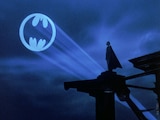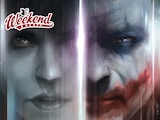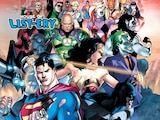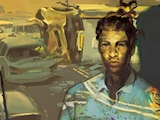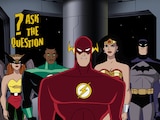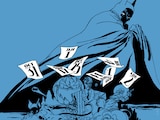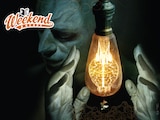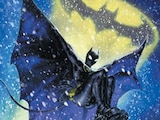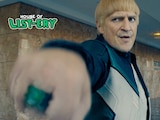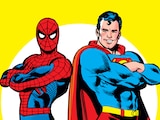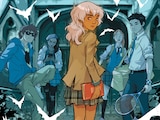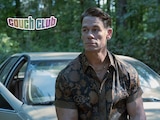Christian Ward’s Batman: City of Madness is the latest entry in a growing intersection between two genres that have been a part of comics since the medium began: the horrific, and the heroic. But despite the fact that comics have been a platform for horror stories and superhero stories for nearly a hundred years, the idea of “superhero horror” seems like it should be an oxymoron. A self-conflicting ideal. One genre is the ultimate power fantasy, while the other is predicated upon a feeling of powerlessness in the face of an overwhelming scenario. So, when heroes are designed to ultimately defeat any problem and emerge triumphant, no matter how great the evil which opposes them, how can these two ideas coexist in the same story?
It’s a question many writers have addressed in their own way, and one which, as it happens, has no singular answer. Crafting a tale of super-thrills and terror chills in equal measure is no simple feat, but with creativity, it’s something we’ve seen comics rise to meet many times. It all goes to show that in comics, given the proper approach, even the seemingly self-contradictory is possible.

Embracing the Unfamiliar
The cornerstone of much great horror boils down to the same essential fear: a fear of the unknown. By revealing to a hero that their assured understanding of the world may not be what they’ve always assumed, you unground them in a way which leaves them grasping for the familiar as they reorient themselves to a reality they never imagined.
The 2018 Justice League Dark series, for instance, reinvents the rules of magic in a way which leaves all who had taken it for granted contending with horrors from the dark underside of reality. Another classic example is Batman: The Court of Owls, where Batman learns everything he knows about how Gotham City works has always been wrong. It’s fitting, then, that the court plays a significant role in City of Madness, which invokes the same terror of the unknown found in more Lovecraftian stories.

A Shift in Perspective
Sure, the hero always wins, but not everyone can be the hero. Last year’s Aquaman: Andromeda is a terrific example of that, which places the story’s focus on a group of scientific researchers and fortune seekers exploring the treasures and mysteries of the deep. Even when Aquaman himself appears, it’s as an unmistakably inhuman presence—another piece of scene setting for the horror story our protagonists face as they discover some treasures are sunken for a reason. Another example is Jeff Lemire’s Joker: Killer Smile, where an average psychotherapist takes on the challenge of the most evil mind in Gotham City. What’s the worst that can happen?

The Inciting Horror
Superhero stories are stories of hope and triumph of good over evil, all of which feels contradictory to horror. But one thing most superhero stories also have in common is an initial trauma. Think about the destruction of Krypton. The betrayal and subjugation of the Amazon people. That infamous night in Crime Alley. Go back far enough and you’ll find the thing in our heroes’ pasts which haunts them the most, providing fodder for a deeply personal kind of horror—as seen throughout the DC Universe just this summer in the Knight Terrors event.
Ever wonder why all of the Knight Terrors tie-in series exploring each hero’s fears are two issues? Here’s my theory: because if you stop after the first one, that’s a classic one-shot horror story for you. It’s only the second which gives you that triumphant superhero resolution. As Neil Gaiman told us in The Sandman, the key to storytelling is knowing where to stop.

Finding the Fear
The fantastic elements of superheroes that make them impossible in the real world is a huge component of their appeal. Sometimes it’s best not to think about exactly how they work and to just enjoy the fantasy for what it is. But sometimes, a richer story can be found in exploring the intricacies. What must life be like for Wally West, when he perceives time at a glacial, eternal pace compared to the typical human experience? When Animal Man draws on the powers of the animal kingdom, what happens to his body? Stories like the current ongoing run on The Flash or the standout New 52 Animal Man series explore these questions in earnest, finding the inherent horror that’s always lurked within, but which we’ve taken for granted.

Starting from the Other Side
All of these strategies we’ve discussed today have concerned telling a horror story with superheroes. But that’s not the only way a genre mashup works. What happens when you start with horror, and make it a superhero story? Well, that’s how you get Swamp Thing. That’s how you get Hellblazer. That’s how you get Doom Patrol, I, Vampire and Creature Commandos. Totemically speaking, horror icons and superheroes have more in common than they don’t. Both loom large in our psyche as beings of great power capable of supernatural feats. Sometimes they’re against us, but sometimes, when forced to face each other, even the most horrifying of them will fight for us.
Batman: City of Madness approaches superhero horror from both ends. We begin with our hero, Batman, discovering horror. But as you’ll discover yourself, it’s also about a horror, in its own way, finding heroism. What happens when these two traditions of storytelling start from opposite ends and meet each other in the middle? Whether you’re a superhero believer or a horror junkie, it’s going to be a bloody good time.
Alex Jaffe is the author of our monthly "Ask the Question" column and writes about TV, movies, comics and superhero history for DC.com. Follow him on Bluesky at @AlexJaffe and find him in the DC Community as HubCityQuestion.
NOTE: The views and opinions expressed in this feature are solely those of Alex Jaffe and do not necessarily reflect those of DC Entertainment or Warner Bros., nor should they be read as confirmation or denial of future DC plans.

